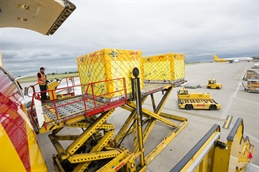
In mid-November, forwarder UTi did something it had not planned for since 2010. The company chartered a B747 freighter to move cargo from Shanghai to Chicago. The charters kicked off on November 24, followed by a second flight on December 1.
“Congestion at West Coast US ports has reached a critical level, and we think it will get worse before we see any improvements,” said Ed Feitzinger, UTi’s executive vice president, global operations. He added that demand for airfreight had surged to levels not seen in years.
“I think we are seeing a similar trend as what you would call a traditional peak,” said Michael Steen, executive vice president and chief commercial officer of Atlas Air.
The peak season surge in traffic, with shippers and forwarders scrambling to find lift, is back with a vengeance. Many operators had given up the phenomenon as a ghost of yesteryear, replaced with a string of mini peaks strung out throughout the year. In 2012 and 2013, no forwarder lined up charters in anticipation of the peak as they had traditionally done in the past.
UTi has not been not alone in its efforts to secure additional lift from Asia to North America. DHL Global Forwarding, the world’s largest forwarder, got the ball rolling back in October when it secured long-term capacity on some of the world’s busiest trade lanes, in response to carrier rates have been climbing as a result of shortfalls in freight capacity.
“As global trade picks up – fuelled by spiking demands in technology – DHL is seeing customer volumes increase on many trade lanes, especially in Asia Pacific. In this scenario, where capacity is tightening and demand is rising, upward pressure on prices is virtually unavoidable,” said DGF CEO Roger Crook.
The rise in global trade volumes, particularly on the transpacific sector, has been boosted by the launch of new must-have mobile technology products from Apple and Samsung. However, operators stressed that these new gadgets were only part of a broader picture of a surge in demand.
“There were some iPhones, but also a lot of other stuff,” noted Shawn McWhorter, president for the Americas at Nippon Cargo Airlines (NCA).
He added that demand had built up months before the peak season. Hawaiian Airlines also saw volumes rise earlier on. “We had our best month ever in September,” said Tim Strauss, vice president of cargo at Hawaiian.
For all the signs of a recovery, the growth in demand was not expected to wipe out the overcapacity that had characterized the transpacific market in recent years. Operators had sidelined some freighters to offset the decline in yields, but still capacity growth continued to outpace demand, thanks to huge increases in bellyhold lift, plus the arrival of more B747-8Fs. Most of these prompted the departure of the smaller B747-400Fs that they replaced, but this still meant a 30-ton boost in payload in each case.
What tipped the balance for good was the worsening congestion at North American West Coast ports. According to the Canadian International Freight Forwarders Association (CIFFA), this has prompted shippers to divert thousands of tons of ocean cargo to airfreight.
“Scheduled carriers are flying full and air charter rates inbound from Asia are through the roof,” the association warned its members. CIFFA urged its members to advise their customers they should consider delays of up to three weeks at West Coast ports and to be prepared for continuous delays into the first quarter of 2015.
Airlines have been happy to oblige and pick up freight moved over from ocean cargo, but some, at least, are facing limits. By the start of December, NCA had sold out its capacity through December 22.
“Customers have bought 100 percent of my capacity,” reported McWhorter. “I am turning down opportunities for the peak because I do not have enough capacity.”
By Ian Putzger
Air Freight Correspondent | Toronto




